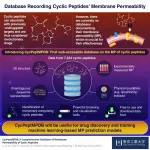(Press-News.org) Space is the great unknown — very few of us will ever experience what it’s like to visit another planet or moon, and so much is yet to be discovered. Below are some recent papers published in ACS journals that report advances toward understanding whether certain minerals, compounds or even life itself could form on other worlds. Reporters can request free access to these papers by emailing newsroom@acs.org.
“Immunoanalytical Approach for Detecting and Identifying Ancestral Peptide Biomarkers in Early Earth Analogue Environments”
Analytical Chemistry
March 16, 2023
These authors reasoned that if they could analyze “resurrected” early Earth proteins — building blocks of life — then they could use this information to develop assays to look for these compounds on other planets. With the approach, the team made antibodies against peptides in eight resurrected proteins. When the researchers used the antibodies to search early Earth-like environments, such as hydrothermal areas, the antibodies bound to old versions of two different proteins. The method could be used to analyze Martian samples that will arrive on Earth by the mid-2030s.
“Experimental Characterization of the Pyridine:Acetylene Co-crystal and Implications for Titan’s Surface”
ACS Earth and Space Chemistry
Feb. 28, 2023
Titan is Saturn’s largest moon, and it contains many organic molecules on its surface and in its atmosphere. These compounds could react and form co-crystals, which are a kind of stable microscopic mineral held together with weak intermolecular interactions. Understanding these minerals could help scientists assess if life could have existed there. Several co-crystals have been experimentally shown to be possible on Titan, but no one had investigated whether pyridine:acetylene could form. The researchers put this co-crystal to the test and demonstrated that it could exist on Titan.
“Does It “Rain” Diamonds on Neptune and Uranus?”
ACS Earth and Space Chemistry
Feb. 8, 2023
More than 40 years ago, a researcher proposed that the surfaces of Neptune and Uranus could be littered with diamonds that formed from hydrocarbons in those planets’ high-temperature and high-pressure environments. Over the years, various scientists tested this in the lab under similar conditions, and said that according to their data, this was possible. Now, a team shows that those previous results were an artifact. The heaters that other groups used were playing a role in diamond formation, leading to erroneous interpretations.
The American Chemical Society (ACS) is a nonprofit organization chartered by the U.S. Congress. ACS’ mission is to advance the broader chemistry enterprise and its practitioners for the benefit of Earth and all its people. The Society is a global leader in promoting excellence in science education and providing access to chemistry-related information and research through its multiple research solutions, peer-reviewed journals, scientific conferences, eBooks and weekly news periodical Chemical & Engineering News. ACS journals are among the most cited, most trusted and most read within the scientific literature; however, ACS itself does not conduct chemical research. As a leader in scientific information solutions, its CAS division partners with global innovators to accelerate breakthroughs by curating, connecting and analyzing the world’s scientific knowledge. ACS’ main offices are in Washington, D.C., and Columbus, Ohio.
To automatically receive news releases from the American Chemical Society, contact newsroom@acs.org.
Follow us: Twitter | Facebook | LinkedIn | Instagram
END
Recent advances in space chemistry research
2023-04-05
ELSE PRESS RELEASES FROM THIS DATE:
Survey of allergists/immunologists reveals management of hereditary angioedema differs by region
2023-04-05
ARLINGTON HEIGHTS, Ill. (April 5, 2023) – Hereditary angioedema (HAE) is a disease that, due to its rare nature, can pose difficulties for both patients and medical professionals. A new survey of allergists/immunologists from the American College of Allergy, Asthma and Immunology (ACAAI) shows that diagnosing, treating and managing this condition can be challenging for patients and healthcare providers - including patients in rural areas. An article about the survey is published in Annals of Allergy, Asthma and Immunology, ACAAI’s scientific journal.
HAE is caused by a genetic mutation, and there are different types. It is a hereditary disease. The symptoms of HAE ...
SynGAP Research Fund awards a collaborative grant to Tang Lab & AXONIS Therapeutics
2023-04-05
PALO ALTO, Calif. (April 5, 2023) – SynGAP Research Fund (SRF), a 501(c)(3) public charity whose mission is to improve the quality of life for SYNGAP1 patients through the research and development of treatments, therapies and support systems, today announced they have awarded a $130,000 collaborative grant to the lab of Xing Tang, PhD at Boston Children's Hospital & AXONIS Therapeutics to investigate the treatment effects of KCC2-enhancing small molecule compounds in SYNGAP1 haploinsufficiency.
Principal Investigator of translational neuroscience at AXONIS, Dr. Kadam, has been working with the SRF community for many years. While at Johns Hopkins, she gave a popular SRF ...
Manganese in Central Valley water threatens fetuses and children
2023-04-05
Water in California’s Central Valley contains enough manganese to cause cognitive disabilities and motor control issues in children, and Parkinson’s-like symptoms in adults.
A naturally occurring metal, manganese is found in water supplies throughout the world. It is regulated as a primary contaminant in many Southeast Asian countries where the climate causes it to leach into groundwater. However, in the U.S. it is regulated only as a secondary contaminant, meaning no maximum level is enforced.
A ...
Do altered gut microbes affect risk of attention-deficit/hyperactivity disorder?
2023-04-05
New research published in the Journal of Child Psychology and Psychiatry suggests that the microbial composition of the gut may affect a child’s susceptibility to attention-deficit/hyperactivity disorder (ADHD).
The human gastrointestinal tract hosts a large population of microorganisms such as bacteria, viruses, and fungi. When investigators compared fecal samples from 35 children with ADHD and 35 healthy controls, samples from children with ADHD had higher levels of certain species of fungi and lower levels of other species.
In experiments with cells grown in the lab, one species in abundance in ...
Can a drug used to treat liver disease help prevent SARS-CoV-2 infections and lessen COVID-19 severity?
2023-04-05
SARS-CoV-2, the virus that causes COVID-19, attaches to a cellular receptor called angiotensin-converting enzyme 2 (ACE2), and activation of the farnesoid X receptor increases ACE2 expression. New research published in the Journal of Internal Medicine suggests that a drug that inhibits the farnesoid X receptor and is used to treat liver disease may decrease SARS-CoV-2 infections and reduce the severity of COVID-19.
The study ran from March 2020 to February 2022 and included 3,214 patients with liver disease, half of whom were taking the drug, called ursodeoxycholic acid (UDCA). ...
Can some snakes do cartwheels to escape or startle predators?
2023-04-05
In research published in Biotropica, investigators report that the Dwarf Reed Snake (Pseudorabdion longiceps) performs cartwheels when threatened. This is the first time such an active rolling motion has been documented in snakes, with images and a detailed description.
The Dwarf Reed Snake is a nocturnal, small snake that lives in regions of Southeast Asia. Typical defense mechanisms that small snakes use against predators include fleeing, camouflage, coloration, odors, death-feigning, and intimidation. ...
Can phototherapy improve cognitive function in patients with dementia?
2023-04-05
In an analysis of published clinical trials, investigators found that phototherapy—or exposure to sessions of bright light—may be a promising non-pharmacological intervention for lessening symptoms of dementia.
The analysis in Brain and Behavior included 12 randomized clinical trials. Results indicated that phototherapy improved cognitive function in patients with dementia, but it did not affect symptoms of depression or sleep quality.
“Further well-designed studies are needed to explore the most effective clinical implementation ...
Could a novel small molecule slow or reverse the effects of Duchenne muscular dystrophy?
2023-04-05
In a new study published in The FASEB Journal, investigators demonstrated the potential of a molecule that may help overcome some of the devastating symptoms of Duchenne muscular dystrophy (DMD), the most common life-limiting congenital neuromuscular disorder. The agent promotes the activity of AMP-activated protein kinase (AMPK), an important fuel-sensing enzyme that is present in all mammalian cells.
Previous research has shown that stimulating AMPK can mitigate the dystrophy—or wasting—of muscles, but AMPK activators have failed to reach the clinic due to either their lack of potency or toxic off-target effects.
In ...
CycPeptMPDB: A database aimed at promoting drug design using cyclic peptides
2023-04-05
CycPeptMPDB, a novel database—created by Tokyo Tech researchers—focused on the membrane permeability of cyclic peptides, could accelerate the development of drugs based on these promising compounds. This database was created by gathering published information on thousands of cyclic peptides and organizing it neatly in an online-accessible platform. Thanks to its search and visualization capabilities, CycPeptMPDB could pave the way to new computational and machine learning methods for screening and designing drugs with cyclic peptides.
One of the ...
Brain injury toolkit helps support domestic violence survivors
2023-04-05
COLUMBUS, Ohio – A new approach to trauma-informed care developed by domestic violence survivor advocates and researchers at The Ohio State University has been found in a new study to improve support organizations’ care for survivors by better recognizing brain injury and addressing its often long-lasting repercussions.
The study appears in the Journal of Head Trauma and Rehabilitation.
CARE is the first trauma-informed approach that considers brain injury in the complex set of circumstances to be addressed and accommodated in order ...

